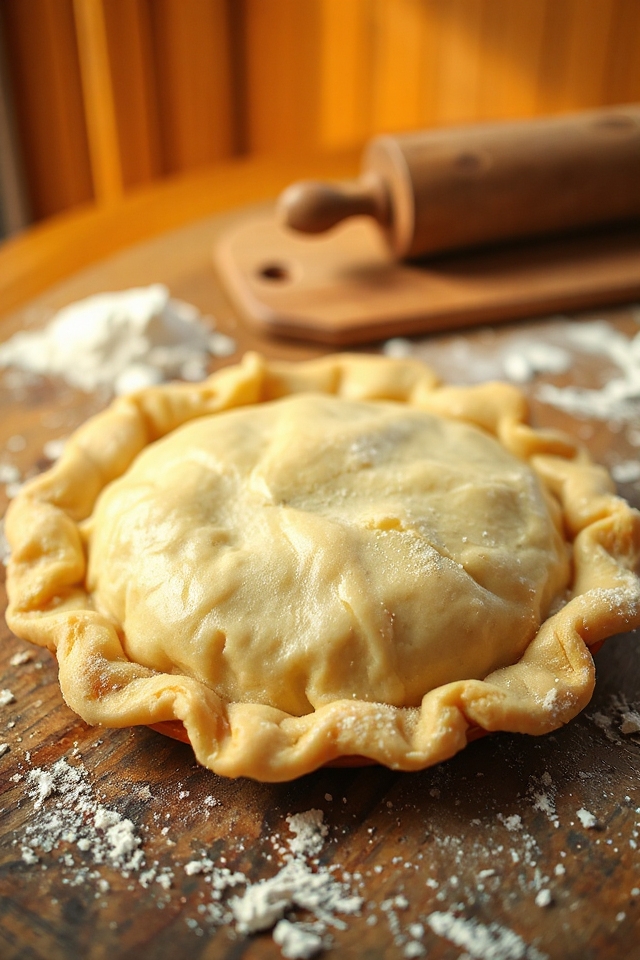Why You’ll Love This Homemade Pie Crust Recipe
When you make this homemade pie crust, you’ll quickly realize why it’s a kitchen staple. It’s incredibly versatile, fitting perfectly with both sweet and savory fillings.
I love how it gives a flaky, buttery texture that store-bought options just can’t match. Plus, it’s surprisingly easy to whip up! You’ll find satisfaction in creating something from scratch that elevates your baking.
The aroma that fills your kitchen while it bakes is heavenly, too. Once you try this recipe, I guarantee you’ll never go back to pre-made crusts. It’s a culinary skill you’ll cherish and enjoy sharing with others!
Ingredients of Homemade Pie Crust
When it comes to making a delicious homemade pie crust, the ingredients are surprisingly simple yet oh-so-important. You might be thinking, “How can something so basic be so good?” Well, the secret lies in the quality of the ingredients and how they come together to create that perfect, flaky texture.
Plus, you can feel like a total kitchen rockstar when you whip up something from scratch. So, let’s plunge into what you need to get started on this culinary adventure.
Ingredients for Homemade Pie Crust:
- 2 cups all-purpose flour
- 1/2 teaspoon salt
- 8 tablespoons shortening or 8 tablespoons butter, chilled and diced
Now, let’s chat about these ingredients a little more. The flour is your foundation, and using all-purpose flour typically yields the best results for a tender crust.
Don’t skip the salt; it may seem small, but it really brings out the flavors in the crust. As for the fat, whether you choose shortening or butter, each has its pros and cons.
Butter gives a rich flavor and a nice golden color, while shortening can create an even flakier texture. And hey, if you’re feeling adventurous, you can even mix the two for a little bit of both worlds.
Just remember, keep that fat cold! It’s the key to achieving that perfect flakiness we all love. So gather your ingredients, and let’s get ready to make some pie magic!
How to Make Homemade Pie Crust

Alright, let’s roll up our sleeves and plunge into the art of making a homemade pie crust. It may sound a little intimidating, but trust me, it’s easier than it seems!
First things first, grab your 2 cups of all-purpose flour and 1/2 teaspoon of salt. Sift them together in a bowl. This is where we start building that flaky foundation. You want everything mixed well, so don’t be shy about giving it a good stir.
Now, it’s time to add the star of the show: the fat. Whether you’re going with 8 tablespoons of shortening or butter, make sure it’s chilled and diced. This is vital; cold fat is your friend in the quest for a flaky crust.
Using your fingers, rub that fat into the flour mixture until it looks crumbly. If you’re feeling fancy, you could even use a pastry cutter, but honestly, your hands do just fine—just make sure to wash them first.
Now, sprinkle 3 tablespoons of ice water over the mixture. Don’t just dump it all in at once; gently toss it with a fork to moisten the flour. If it looks like it needs a little more hydration, go ahead and add another tablespoon of ice water, but do it gradually. The goal is to form a cohesive dough without it becoming too wet.
Once you’ve got your dough looking nice and ready, gather it into a ball. Don’t stress if it feels a bit crumbly; it’s supposed to be like that. Wrap it up in some plastic wrap or waxed paper and pop it in the fridge for at least 30 minutes.
This chilling time is where the magic happens, as it allows the gluten to relax and guarantees that your crust won’t shrink when you bake it. So, while you wait, maybe consider what delicious filling you’ll be adding to your freshly made pie crust.
Just don’t forget about it in there—trust me, I’ve had my fair share of neglected dough that turned into a science experiment.
Homemade Pie Crust Substitutions & Variations
While making a homemade pie crust is a delightful process, there are plenty of substitutions and variations you can explore to suit your taste or dietary needs.
For a gluten-free option, try using a gluten-free flour blend. If you prefer a richer flavor, substituting half the shortening with cream cheese works wonders.
You can also experiment with different fats—coconut oil or ghee can add unique tastes. For a sweet pie, adding a tablespoon of sugar to the flour enhances the crust.
Don’t hesitate to play around with herbs or spices to create a crust that complements your filling perfectly!
What to Serve with Homemade Pie Crust
A homemade pie crust opens up a world of delicious possibilities for what you can serve alongside it.
Personally, I love filling it with seasonal fruits like apples or berries, topped with a scoop of vanilla ice cream for a classic dessert.
For something savory, a quiche filled with fresh vegetables and cheese is perfect, especially for brunch.
You can also try a pot pie with hearty fillings like chicken and mushrooms.
And don’t forget about serving warm, sliced pie with whipped cream or a drizzle of caramel sauce.
Each option complements that flaky, buttery crust beautifully!
Additional Tips & Notes
When enjoying your homemade pie crust, it’s helpful to keep a few additional tips in mind to guarantee the best results. First, make sure your ingredients are cold; this helps create a flaky texture.
If you’re using butter, don’t overwork the dough, or it’ll become tough. After chilling, roll the dough out on a floured surface, but do it gently. If your crust cracks, simply patch it with a bit of extra dough.
Finally, always blind bake your crust if you’re filling it with something wet. These small tweaks will elevate your homemade pie crust to perfection!